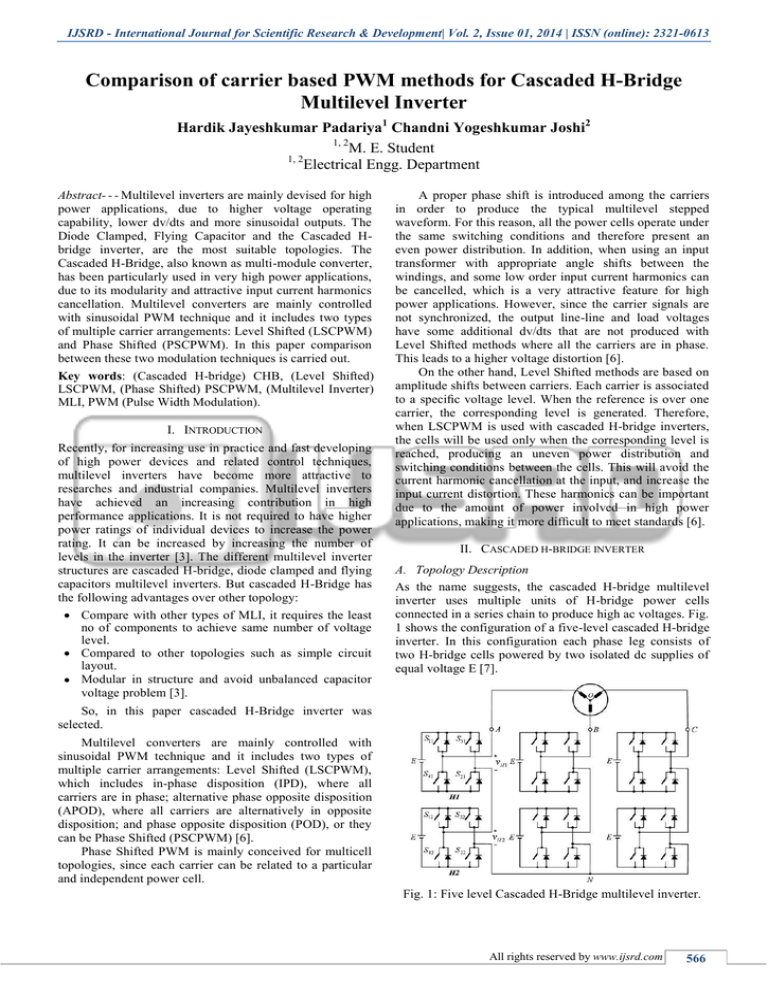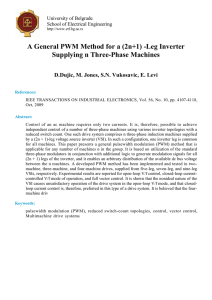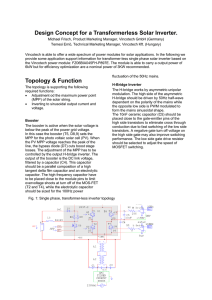
IJSRD - International Journal for Scientific Research & Development| Vol. 2, Issue 01, 2014 | ISSN (online): 2321-0613
Comparison of carrier based PWM methods for Cascaded H-Bridge
Multilevel Inverter
Hardik Jayeshkumar Padariya1 Chandni Yogeshkumar Joshi2
1, 2
M. E. Student
1, 2
Electrical Engg. Department
Abstract- - - Multilevel inverters are mainly devised for high
power applications, due to higher voltage operating
capability, lower dv/dts and more sinusoidal outputs. The
Diode Clamped, Flying Capacitor and the Cascaded Hbridge inverter, are the most suitable topologies. The
Cascaded H-Bridge, also known as multi-module converter,
has been particularly used in very high power applications,
due to its modularity and attractive input current harmonics
cancellation. Multilevel converters are mainly controlled
with sinusoidal PWM technique and it includes two types
of multiple carrier arrangements: Level Shifted (LSCPWM)
and Phase Shifted (PSCPWM). In this paper comparison
between these two modulation techniques is carried out.
Key words: (Cascaded H-bridge) CHB, (Level Shifted)
LSCPWM, (Phase Shifted) PSCPWM, (Multilevel Inverter)
MLI, PWM (Pulse Width Modulation).
I. INTRODUCTION
Recently, for increasing use in practice and fast developing
of high power devices and related control techniques,
multilevel inverters have become more attractive to
researches and industrial companies. Multilevel inverters
have achieved an increasing contribution in high
performance applications. It is not required to have higher
power ratings of individual devices to increase the power
rating. It can be increased by increasing the number of
levels in the inverter [3]. The different multilevel inverter
structures are cascaded H-bridge, diode clamped and flying
capacitors multilevel inverters. But cascaded H-Bridge has
the following advantages over other topology:
Compare with other types of MLI, it requires the least
no of components to achieve same number of voltage
level.
Compared to other topologies such as simple circuit
layout.
Modular in structure and avoid unbalanced capacitor
voltage problem [3].
A proper phase shift is introduced among the carriers
in order to produce the typical multilevel stepped
waveform. For this reason, all the power cells operate under
the same switching conditions and therefore present an
even power distribution. In addition, when using an input
transformer with appropriate angle shifts between the
windings, and some low order input current harmonics can
be cancelled, which is a very attractive feature for high
power applications. However, since the carrier signals are
not synchronized, the output line-line and load voltages
have some additional dv/dts that are not produced with
Level Shifted methods where all the carriers are in phase.
This leads to a higher voltage distortion [6].
On the other hand, Level Shifted methods are based on
amplitude shifts between carriers. Each carrier is associated
to a specific voltage level. When the reference is over one
carrier, the corresponding level is generated. Therefore,
when LSCPWM is used with cascaded H-bridge inverters,
the cells will be used only when the corresponding level is
reached, producing an uneven power distribution and
switching conditions between the cells. This will avoid the
current harmonic cancellation at the input, and increase the
input current distortion. These harmonics can be important
due to the amount of power involved in high power
applications, making it more difficult to meet standards [6].
II. CASCADED H-BRIDGE INVERTER
A. Topology Description
As the name suggests, the cascaded H-bridge multilevel
inverter uses multiple units of H-bridge power cells
connected in a series chain to produce high ac voltages. Fig.
1 shows the configuration of a five-level cascaded H-bridge
inverter. In this configuration each phase leg consists of
two H-bridge cells powered by two isolated dc supplies of
equal voltage E [7].
So, in this paper cascaded H-Bridge inverter was
selected.
Multilevel converters are mainly controlled with
sinusoidal PWM technique and it includes two types of
multiple carrier arrangements: Level Shifted (LSCPWM),
which includes in-phase disposition (IPD), where all
carriers are in phase; alternative phase opposite disposition
(APOD), where all carriers are alternatively in opposite
disposition; and phase opposite disposition (POD), or they
can be Phase Shifted (PSCPWM) [6].
Phase Shifted PWM is mainly conceived for multicell
topologies, since each carrier can be related to a particular
and independent power cell.
Fig. 1: Five level Cascaded H-Bridge multilevel inverter.
All rights reserved by www.ijsrd.com
566
Comparison of carrier based PWM methods for Cascaded H-Bridge Multilevel Inverter
(IJSRD/Vol. 2/Issue 01/2014/146)
The CHB inverter in Fig. 1 can produce a phase
voltage with five voltage levels. When switches S11, S21,
S12, and S22 conduct, the output voltage of the H-bridge
cells H1and H2 is VH1= VH2= E, and the resultant inverter
phase voltage is VAN= VH1+ VH2= 2E, which is the
voltage at the inverter terminal A with respect to the
inverter neutral N. Similarly, with S31, S41, S32, and S42
switched on, V= –2E [7].
The number of voltage levels in a CHB inverter
can be found from m = (2H + 1).
Where H is the number of H-bridge cells per phase
leg. The voltage level m is always an odd number for the
CHB inverter while in other multilevel topologies such as
diode-clamped inverters; it can be either an even or odd
number [7].
that for the phase-shifted modulation scheme. The
multilevel converter with multilevel requires (m1) triangular
carriers with same amplitude and frequency [5].
The amplitude modulation index ‘ma’ is defined by
ma = Vm / Vcr (m-1) for 0 ≤ ma ≤ 1. Where Vm is the peak
value of the modulating wave and Vcr is the peak value of
the each carrier wave. The triggering circuit is designed
based on the three phase sinusoidal modulation waves Va,
Vb, and Vc. Three of the sine wave sources have been
obtained with same amplitude and frequency but displaced
120° out of the phase with each other [5].
III. CASCADED H-BRIDGE INVERTER MODULATION
Multilevel converters are mainly controlled with sinusoidal
PWM technique and it includes two types of multiple
carrier arrangements: Level Shifted (LSCPWM) and Phase
Shifted (PSCPWM) [6].
A. Phase shifted carrier PWM (PSCPWM)
Fig. 3: PD method with Level shifted carrier pulse width
modulation for seven-level inverter.
C. Phase disposition technique
In phase disposition method (Fig. 4) all the carriers have
the same frequency and amplitude. Moreover all the
carriers are in phase with each other. They differ only in
DC offset [2].
Fig. 2: Phase shifted carrier pulse width modulation for
three-level inverter.
Fig. 2 shows the Phase shifted carrier pulse width
modulation. In general, a multilevel inverter with m voltage
levels requires (m–1) triangular carriers. In the phase
shifted multicarrier modulation, all the triangular carriers
have the same frequency and the same peak-to-peak
amplitude, but there is a phase shift between any two
adjacent carrier waves, given by φcr = 3600/ (m – 1). The
modulating signal is usually a three-phase sinusoidal wave
with adjustable amplitude and frequency. The gate signals
are generated by comparing the modulating wave with the
carrier waves.
It means that, if five level inverter, four triangular
carriers are needed with a 90° phase displacement between
any two adjacent carriers. In this case the phase
displacement of Vcr1 = 0°, Vcr2 = 90°, Vcr1- = 180° and
Vcr2- = 270° [5].
B. Level shifted carrier PWM (LSCPWM)
The Level shifted carrier pulse width modulation. An mlevel Cascaded H-bridge inverter using level shifted
modulation requires (m–1) triangular carriers, all having the
same frequency and amplitude. The frequency modulation
index is given by mf = fcr / fm, which remains the same as
Fig. 4: APOD method with Level shifted carrier pulse
width modulation for seven-level inverter.
D. Phase opposition disposition technique
Here carriers above the zero reference point are out of
phase with those below zero reference point by 180 (Fig.
6). Frequency and amplitude of carrier waves are the same
but they differ only in DC offset [2].
E. Alternate Phase opposition disposition technique
In APOD Method (Fig. 5) all the carriers have the same
amplitude, frequency and diff erent DC off set. Each carrier
is phase shifted by 1800from the adjacent carrier [2].
All rights reserved by www.ijsrd.com
567
Comparison of carrier based PWM methods for Cascaded H-Bridge Multilevel Inverter
(IJSRD/Vol. 2/Issue 01/2014/146)
Fig. 5: POD method with Level shifted carrier pulse width
modulation for seven-level inverter.
Fig. 8: Phase to phase Voltage and current wave form of
PSCPWM
IV. SIMULATION
A. Simulation Parameters
Each H-bridge module input voltage = 100v dc
System frequency = 50Hz
Carrier frequency = 1KHz
Load: Active power = 10KW, Inductive Reactive
power = 500VAR
Smoothening Reactor=100mH
ma=1
mf=20
B. Simulation block diagram
Fig. 9: FFT Analysis of phase to phase voltage of
PSCPWM
Fig. 10: FFT Analysis of current of PSCPWM
B. Phase Disposition with LSCPWM
Fig. 6: Simulation block of 1-phase.
V. SIMULATION RESULTS
Fig. 11: PD with LSCPWM
A. Phase shift carrier PWM method
Fig. 7: Phase shift carrier PWM
Fig. 12 : Phase to phase Voltage and current wave form of
PD with LSCPWM
All rights reserved by www.ijsrd.com
568
Comparison of carrier based PWM methods for Cascaded H-Bridge Multilevel Inverter
(IJSRD/Vol. 2/Issue 01/2014/146)
Fig. 13: FFT Analysis of phase to phase of PD with
LSCPWM
Fig. 18 FFT Analysis of current of POD with LSCPWM
D. Alternate Phase opposition disposition with LSCPWM
Fig. 14: FFT Analysis of current of PD with LSCPWM
C. Phase opposition disposition with LSCPWM
Fig. 15: POD with LSCPWM
Fig. 16: Phase to phase Voltage and current wave form of
POD with LSCPWM
Fig. 17: FFT Analysis of phase to phase voltage of POD
with LSCPWM
Fig. 19 : APOD with LSCPWM
Fig. 20: Phase to phase Voltage and current wave form of
APOD with LSCPWM
Fig. 21: FFT Analysis of phase to phase voltage of APOD
with LSCPWM
Fig. 22: FFT Analysis of current of APOD with LSCPWM
All rights reserved by www.ijsrd.com
569
Comparison of carrier based PWM methods for Cascaded H-Bridge Multilevel Inverter
(IJSRD/Vol. 2/Issue 01/2014/146)
[3]
Fig. 23: H-bridge cell voltage for LSCPWM
[4]
[5]
[6]
Fig. 24 H-bridge cell voltage for PSCPWM
E. Simulation Result Table
Sr.
No.
Modulation
technique
THD (%)
in Voltage
THD (%)
in
Current
1.
PSCPWM
29.09
4.49
2.
PD with LSCPWM
17.12
2.65
3.
POD
LSCPWM
APOD
LSCPWM
with
21.49
2.65
with
25.11
2.69
4.
[7]
APPLIED FOR MULTI–LEVEL SHUNT ACTIVE
FILTER", Journal of ELECTRICAL ENGINEERING,
VOL. 63, pp 261–265, 2012.
P.Palanivel, Subhransu Sekher and Dash, "Phase
Shifted Carrier Pulse Width Modulation for Three
Phase Multilevel Inverter to Minimize THD and
Enhance Output Voltage Performance", Power
Electronics Laboratory, SRM University, Chennai,
Tamilnadu, India, 2010.
C. Boonmee and Y. Kumsuwan, "A Phase-shifted
Carrier-Based PWM Technique for Cascaded H-bridge
Inverters Application in Standalone PV System", 15th
International Power Electronics and Motion Control
Conference, 2012.
M Vijaya Krishna and K K C Deekshit, "Comparison of
Hybrid PWM Technique for Cascaded Multilevel
Inverter",
INTERNATIONAL
JOURNAL
OF
ADVANCED SCIENTIFIC RESEARCH AND
TECHNOLOGY ISSUE 2, VOLUME 3 JUNE- 2012.
Mauricio Angulo, Pablo Lezana, Samir Kouro, Jos´e
Rodr´iguez and Bin Wu, "Level-shifted PWM for
Cascaded Multilevel Inverters with Even Power
Distribution", IEEE Transaction, pp 2373-2378, 2007.
BIN WU, “High-Power Converter and AC Drives”, A
JOHN WILEY & SONS, INC, PUBLICATION, 2006,
pp 119-142.
Table. 1: THD in Current and Phase To Phase Voltage For
Different Technique
VI. CONCLUSION
From the MATLAB/SIMULINK based simulation of the
Multilevel Inverter, results were obtained for all the carrier
based PWM techniques. Comparison of outputs gives the
idea that Phase Disposition technique gives good harmonic
performance. Also, comparison of H-Bridge voltage of
PSCPWM and LSCPWM gives the idea that the H-Bridge
output voltages produced by phase-shifted modulation are
almost identical.
However, voltages produced by the level-shifted
modulation are not identical so switching frequency and
conduction period are different for all devices. But, for
phase shifted modulation has same switching frequency and
conduction period for all devices.
REFERENCES
[1] Chaiyant Boonmee and Napat Watjanatepin, "
Comparison of Using Carrier-Based Pulse Width
Modulation Techniques for Cascaded H-Bridge
Inverters Application in the PV Energy systems",
International Symposium on the Fusion Technologies
between Korea and Thailand 2013, August 1-3, 2013.
[2] Sebasthi Rani Kathalingam and Porkumaran
Karantharaj, "COMPARISON OF MULTIPLE
CARRIER DISPOSITION PWM TECHNIQUES
All rights reserved by www.ijsrd.com
570







